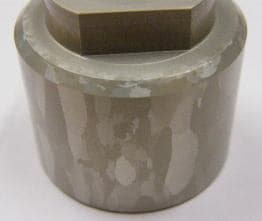
Curated with aloha by
Ted Mooney, P.E. RET

The authoritative public forum
for Metal Finishing 1989-2025

-----
Grainy, Mottled Type 1 Anodize
We have a problem anodizing a specific 7075 alloy. This problem seems to be product specific and does not happen to all of the parts in a lot. The condition is a large grainy pattern, after type 1 anodize, on a machined 7075 alloy. Adding to this problem is that this condition is exhibited on a specific diameter (and possibly an adjacent surface), but not on the other diameters. We don't have this condition on other 7075 alloys that we type 1 anodize.

Plating Shop Employee - Phoenix, Arizona, USA
October 26, 2009
First of two simultaneous responses --
Is the "work hardening" on the "specific diameters" hot enough to cause the zinc to migrate and cause the discoloration? Is the extruded stock "cold drawn"? Is your sulphate contamination over 500 mg/L?

Robert H Probert
Robert H Probert Technical Services
Garner, North Carolina

October 27, 2009
Second of two simultaneous responses --
I'm have a problem exactly like you except I'm using 6061-T6 (extrusion) and using Type 2. Please me me know of anything you find out!
Matt Tomosivitch- New Hampton, NY, USA
October 28, 2009
October 30, 2009
Hello folks,
Go for the easiest solutions first, namely:
Has the dye part been thoroughly rinsed with DI or RO water? City water is terrible especially after rainy days if the water is drawn from a river.
Has the part been recontaminated with any acid sprays in the rinse or dyeing procedure.
Has the dye been contaminated with oil, or is oil present in the dye? Do you see a rainbow on the dye solution surface?
Are you running dye buffers to help with the dye mottle?
Do you see the same problem with running another dye color using the same part?
We see these problems from time to time but it is important to isolate where the problem is coming from.
Good luck on the hunt.
anodizing shop - Newark, Ohio USA
Ron
I have always thought that this was the result of a heat treatment where the quench/cooling was not done quite right, although I have not been able to prove or disprove it. Perhaps machining without adequate coolant could cause this.
The visible grain structure appears to be only on the perimeter of the part, and the adjacent 'ends' show a distinct cross section. Etching and anodizing enhance it.
- Colorado Springs, Colorado
November 2, 2009
Q, A, or Comment on THIS thread -or- Start a NEW Thread